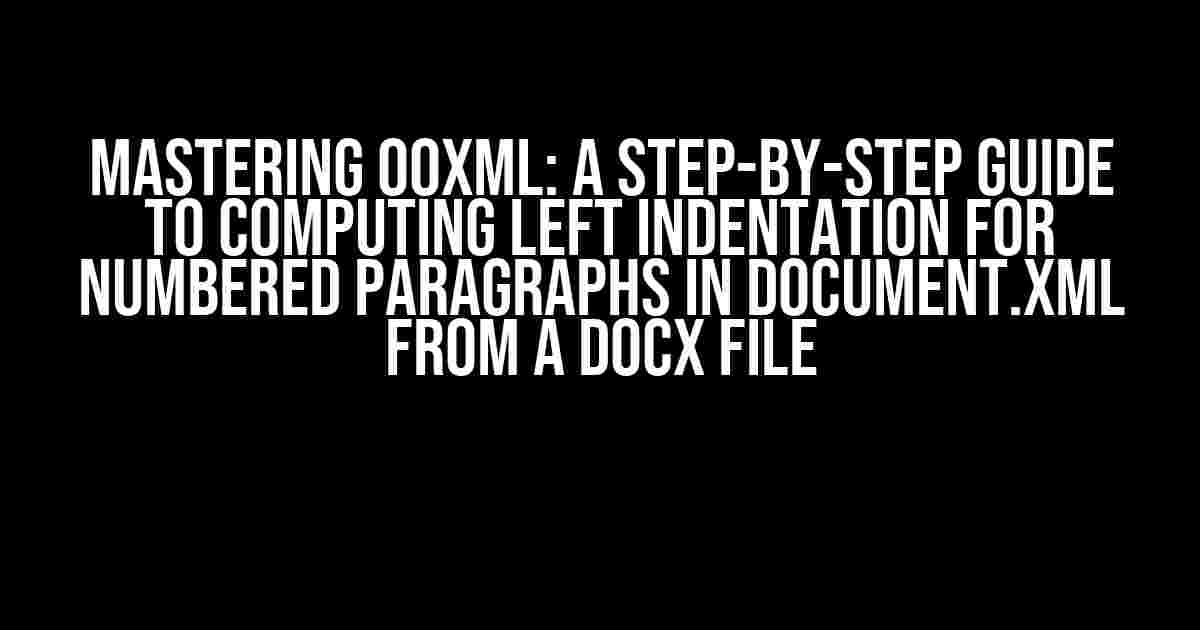Welcome to the world of Open XML (OOXML), where the intricacies of Microsoft Word documents await! In this comprehensive guide, we’ll delve into the process of computing left indentation for numbered paragraphs in the document.xml file of a DOCX file. Buckle up, as we navigate the twists and turns of OOXML to uncover the secrets of precise document formatting.
- What is OOXML, and Why Should You Care?
- The Anatomy of a DOCX File
- Step 1: Extract the document.xml File from the DOCX File
- Step 2: Identify Numbered Paragraphs and Extract Indentation Properties
- Step 3: Compute the Left Indentation
- Step 4: Apply the Computed Left Indentation
- Troubleshooting and Additional Considerations
- Conclusion
What is OOXML, and Why Should You Care?
Open XML, also known as Office Open XML, is an open standard for word processing documents, spreadsheets, and presentations. It’s the underlying structure that makes DOCX files tick. As a developer, understanding OOXML is crucial for manipulating and generating Microsoft Word documents programmatically. In this article, we’ll focus on a specific aspect of OOXML: computing left indentation for numbered paragraphs in the document.xml file.
The Anatomy of a DOCX File
A DOCX file is essentially a container for a collection of XML files, accompanied by supporting files like images and fonts. The document.xml file is the core component, containing the document’s content and formatting instructions. To compute left indentation, we need to explore the following components:
w:pelement: Represents a paragraph in the document.w:pPrelement: Contains paragraph properties, including formatting and indentation.w:numPrelement: Specifies the numbering properties for a paragraph.w:indelement: Defines the indentation properties for a paragraph.
Step 1: Extract the document.xml File from the DOCX File
To access the document.xml file, you’ll need to unzip the DOCX file using a library or tool that supports ZIP archives. For example, in Java, you can use the java.util.zip package. In Python, you can use the zipfile module. Extract the document.xml file and parse it as an XML document.
<?xml version="1.0" encoding="UTF-8" standalone="yes"?> <w:document xmlns:w="http://schemas.openxmlformats.org/wordprocessingml/2006/main"> <!-- content omitted for brevity --> </w:document>
Step 2: Identify Numbered Paragraphs and Extract Indentation Properties
Now that we have the document.xml file, we need to identify paragraphs with numbering and extract their indentation properties. Look for w:p elements that contain a w:numPr element. This indicates a numbered paragraph. Extract the w:ind element, which defines the indentation properties.
<w:p>
<w:pPr>
<w:numPr>
<!-- numbering properties omitted for brevity -->
</w:numPr>
<w:ind w:leftIndent="720"></w:ind>
</w:pPr>
<w:r><w:t>This is a numbered paragraph.</w:t></w:r>
</w:p>
Step 3: Compute the Left Indentation
Now that we have the w:ind element, we can compute the left indentation. The w:leftIndent attribute specifies the left indentation in twentieths of a point (1 point = 1/72 inch). To convert this value to a more meaningful measurement, we can use the following formula:
leftIndentation = w:leftIndent / 20 * pointToPixels
where pointToPixels is a conversion factor that depends on the document’s font and size. For simplicity, let’s assume a standard font size of 12 points and a conversion factor of 1 point = 1.33 pixels. This gives us:
leftIndentation = 720 / 20 * 1.33 ≈ 48.24 pixels
Step 4: Apply the Computed Left Indentation
With the computed left indentation value, you can now apply it to your document or layout engine. Depending on your implementation, this might involve setting a CSS property, modifying a graphical object, or updating a document model.
| Language | Example Code |
|---|---|
| Java | element.setStyle("margin-left", leftIndentation + "px"); |
| Python | element.css["margin-left"] = f"{leftIndentation}px" |
Troubleshooting and Additional Considerations
When working with OOXML, it’s essential to be aware of the following:
w:indelements can be inherited from parent elements, so ensure you’re working with the correct scope.- Numbering schemes can be complex, involving multiple levels and exceptions. Be prepared to handle these scenarios accordingly.
- Conversion factors and font sizes may vary depending on the document’s settings and content. Be flexible and adapt to different scenarios.
Conclusion
Computing left indentation for numbered paragraphs in OOXML’s document.xml file requires a deep understanding of the XML structure and formatting properties. By following these steps and considering the nuances of OOXML, you’ll be well-equipped to tackle even the most complex document formatting tasks. Remember to stay flexible and adapt to the intricacies of OOXML to ensure accurate and efficient document processing.
With this comprehensive guide, you’re now ready to tackle the world of OOXML and master the art of computing left indentation for numbered paragraphs. Happy coding!
Frequently Asked Question
Get the answers to your burning questions about computing left indentation for numbered paragraphs in OOXML (document.xml) from a DOCX file!
What is the purpose of computing left indentation for numbered paragraphs in OOXML?
Computing left indentation for numbered paragraphs in OOXML is crucial to ensure that the formatting of the document is preserved when converting it from a DOCX file. It helps to correctly position the paragraph number and text, making the document more readable and visually appealing.
How do I extract the paragraph numbering information from the DOCX file?
You can extract the paragraph numbering information from the DOCX file by parsing the XML content of the file. Specifically, you need to analyze the `
What is the role of the `` element in computing left indentation?
The `
How do I calculate the left indentation for a numbered paragraph?
To calculate the left indentation for a numbered paragraph, you need to add the values of the `w:start` and `w:left` attributes from the `
Are there any tools or libraries available to simplify the process of computing left indentation?
Yes, there are several libraries and tools available that can simplify the process of computing left indentation, such as OpenXML SDK, docxtemplater, and python-docx. These libraries provide pre-built functions and classes that can help you parse the DOCX file, extract the necessary information, and calculate the left indentation with ease.

